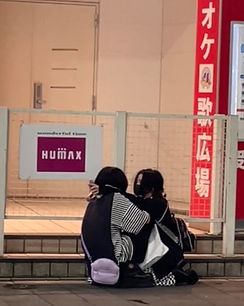
Proxemics
by Miki
Ways Toyoko kids use proxemics to increase intimacy within the Toyoko hiroba
This page will explore on how Toyoko kids increase intimacy with each other through proxemics within the Toyoko Hiroba. How different it is regarding the way they interact with their group members from the rest of the society will be focused on through a micro-perspective.

Introduction
“proximity increases intimacy” - Mark, 1970
Mark (1970) mentioned “proximity increases intimacy”, indicating that there is a correlated relationship between proxemics and intimacy, such as the closer the physical distance among individuals gets, the more intimate the interpersonal relationship among them becomes and vice versa.
This is further supported by Nicolai and Saul, 2015:
“Just as people expect increasing engagement and intimacy as they approach others, so should they naturally expect increasing connectivity and interaction possibilities as they bring themselves and their devices in close proximity to one another. This is called Proxemic Interactions”
This statement by Nicolai and Saul (2015) reinforces Mark (1970)’s remark, mentioning that there is a correlated relationship between an increasing engagement and intimacy, and the growing connectivity and interaction possibilities, which is concluded as the term: Proxemic Interactions.
🔗 Proxemics used to increase intimacy
Fist bump
In Japan, the common way to greet one another is bowing. Greeting with fist bump is barely seen in a day-to-day greeting situation in Japan. However, in Toyoko Hiroba, fist bump is seen quite common when Toyoko kids greet each other. It is more observed among male-male doing fist dump than female-female or different gender. Maybe it is a determined greeting “code” or “culture” for them as it could be seen as a cool way to greet each other. On the other hand, it can also be a way to keep intimate body touch with each other while considering the prevention of the Covid-19 pandemic. Either way, rather than greeting without having body touch, having some body touches is thought to be effective in terms of increasing intimacy with others.

Elbow bump
Similar as the previous fist bump, elbow bump is also seen among Toyoko kids, specifially among male Toyoko Kids when they greet each other. Elbow bump is not commonly used in Japan as a way to greet others as well just as the aforementioned fist bump. Therefore, it is a unique way to greet each other with elbow bump in the Toyoko kids group, whcih is considered a strategy to claim their group identity.
Compared to simply bowing, a little bit of body touch such as elbow bump naturally requires a close physical distance between individuals. This behavior shortens the proxemics between individuals, naturally assuring at least a personal physical space (0.5-1m)or even an intimate physical space (0-50cm) between Toyoko kids. Therefore, elbow bump is considered a way to increase intimacy among Toyoko kids.
High five
Other than fist bump and elbow bump, many Toyoko kids choose to do high-five as a way to greet each other. This is different from the social norm in Japan. However, it can be a special way for Toyoko kids to greet each other, representing Toyoko kids’ group culture to some certain extent.
One common scene observed in the Toyoko hiroba is that Toyoko kids who are in their 20s or who look like a grown up would bend down and do high-five with Toyoko kids who look still quite young such as those who are in their early 10s.
According to Mark, 1970
“choice of position is an indicator of the emotinal tone of the relationship”
The choise of position (Elder Toyoko kids) bending down and do high-five to other younger Toyoko kids rather than standing still and do high-five reveals a sense of consideration or caring toward those who are younger than themselves. It feels like those elder Toyoko kids are seeing those yonuger Toyoko kids as younger sisters and younger brothers, revealing a sense of family.
Pinching necks
“Women would be spatially invaded more frequently than men”

“the unequal power idtribution among men and women would manifest itself in their proxemic behaviors such as the use of distance”
According to Madden (1999), women’s personal space is invaded by men in many of the occasions. This proposed idea is embodied in Toyoko hiroba.
One Toyoko guy was pinching two girls’ necks in a joking way. There is barely any physical distance between the two girls and the guy. Thr proxemics between them fit into the intimate personal space (0-50cm). Judging from two girls’ facial expressions, they didn’t seem to enjoy being pinched by the male Toyoko kid. However, since two female Toyoko kids did not strongly resist, letting the male Toyoko kid keep pinching their necks. Judging from this, it can be concluded as they share a quite close relationship. Such behavior also shows how male Toyoko kids use proxemics to establish a sense of dominance over girls.
Click here for more information about how more male Toyoko kids establish dominance on female Toyoko kids through the use of language in Toyoko hiroba.
Holding hands & Hugging
Holding hands and hugging is a behavior that is usually seen between a couple as it is a romantic gesture. This behaviour is seen among both female-female and male-male Toyoko kids.
The other day, we saw two male Toyoko kids hugging each other in the Toyoko hiroba. It is quite rare to see male-male hugging each other in the public and share intimate personal space with each other (0-50cm). It suggests that the two guys may have been very close to each other or they can be a couple.
“Proxemic Interactions” is embodied here as the closer the physical distance among individuals gets, the more intimate the interpersonal relationship among them becomes. It can be concluded as Toyoko kids increase intimacy with each other through such intimate behaviors.
Besides, although it is common to see female-female holding hands, it is not the case for male-male in a public place. This shows the unique culture of the Toyoko kids’ group as it reveals that there is an atmosphere within the group that allows everyone despite their gender differences to do whatever they want without having to worry about being judged by others. Thus, Toyoko hiroba might be a place represent “freedom” to Toyoko kids, as no one needs to obey the contemporary social norm and can fully present themselves.


Conclusion
“Proxemic Interactions”is a key strategy for Toyoko kids to build a close relationship with other Toyoko kids in the Toyoko hiroba. The use of various types of body touch and the close proxemics all suggest that they try to increase intimacy with other Toyoko kids through a close proxemics as proximity and intimacy is correlated to each other. Regardless of the difference in age and gender, the proxemics between individuals is very close compared to the rest of the society. It is close maybe because of they are purposefully putting effort into enhance the bond with other Toyoko kids or this is the general group norm shared among Toyoko kids. Body touch such as fist bump and elbow bump can also be one of the symbols of Toyoko kids’ culture, making it effective for them to maintain their group identity.
- Three main sections -
Sections
proxemics
